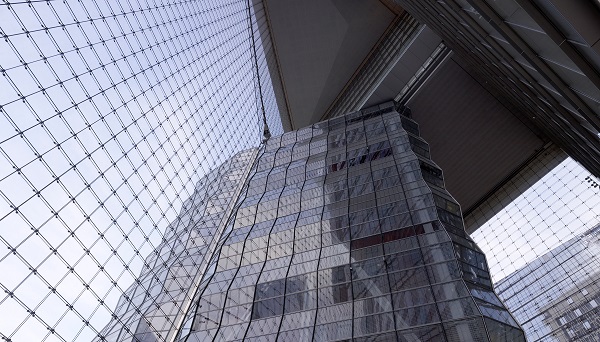Cable net structure
A cable net structure is an example of a tensile structure, i.e. a structure that is stabilised by tension rather than compression. For example, a piece of fabric pulled in opposite directions. For more information see: Tensile structures.
Cable nets were developed and popularised as a minimalist structural system in the 1960s and 70s by Frei Otto, with a new permanence was heralded by the plexi glass clad cable net of the 1972 Munich Olympic Stadium. For more information see: Frei Otto.
The architect Helmut Jahn is often credited with using the system in the most innovative application, when designing the Kempinski Hotel, Munich, in the early-1990s. Jahn adopted the cable net system, creating a structural form of pre-tensioned cables to provide support for a sheer glass curtain wall.
To increase height and load capabilities, horizontal cables can be combined with vertical cable arrangements. By doing so, system designs can be developed for double curvature walls as well as flat walls. For more information see: Anticlastic and Synclastic.
Cable nets are capable of being very simplistic structures. The clean aesthetic and large-spanning potential can be integrated with adjacent structures to reduce the need for conventional supports.
Typically, the cables are locked together at their intersections using a clamping component which may also fix any cladding to the net. Complex hydraulic jacking processes may then be used to apply the cable prestress.

|
| Millennium Dome, London, During Construction. |
[edit] Find out more
[edit] Related articles on Designing Buildings Wiki
Featured articles and news
One of the most impressive Victorian architects. Book review.
RTPI leader to become new CIOB Chief Executive Officer
Dr Victoria Hills MRTPI, FICE to take over after Caroline Gumble’s departure.
Social and affordable housing, a long term plan for delivery
The “Delivering a Decade of Renewal for Social and Affordable Housing” strategy sets out future path.
A change to adoptive architecture
Effects of global weather warming on architectural detailing, material choice and human interaction.
The proposed publicly owned and backed subsidiary of Homes England, to facilitate new homes.
How big is the problem and what can we do to mitigate the effects?
Overheating guidance and tools for building designers
A number of cool guides to help with the heat.
The UK's Modern Industrial Strategy: A 10 year plan
Previous consultation criticism, current key elements and general support with some persisting reservations.
Building Safety Regulator reforms
New roles, new staff and a new fast track service pave the way for a single construction regulator.
Architectural Technologist CPDs and Communications
CIAT CPD… and how you can do it!
Cooling centres and cool spaces
Managing extreme heat in cities by directing the public to places for heat stress relief and water sources.
Winter gardens: A brief history and warm variations
Extending the season with glass in different forms and terms.
Restoring Great Yarmouth's Winter Gardens
Transforming one of the least sustainable constructions imaginable.
Construction Skills Mission Board launch sector drive
Newly formed government and industry collaboration set strategy for recruiting an additional 100,000 construction workers a year.
New Architects Code comes into effect in September 2025
ARB Architects Code of Conduct and Practice available with ongoing consultation regarding guidance.
Welsh Skills Body (Medr) launches ambitious plan
The new skills body brings together funding and regulation of tertiary education and research for the devolved nation.
Paul Gandy FCIOB announced as next CIOB President
Former Tilbury Douglas CEO takes helm.
























